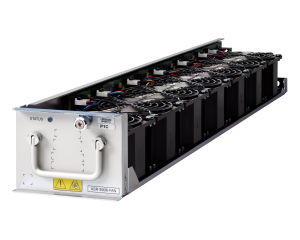Optimize Power Consumption

Optimize Power Consumption with the 4th generation of ASR 9000 line cards
Why Power Consumption matters
Power consumption has always been a heated topic and there are several good reasons to that.
The most obvious is that each Watt consumed by a router generates some direct costs. The electric utility company has to be paid for all the power the box consumes. Therefore, optimizing a router’s power consumption has a direct impact on OpEx costs.
However, this is not the only reason why Service Providers are keeping a close eye on power consumption. There are two other areas where power consumption drives additional costs.
First, the whole onsite power installation also generates costs. If the datacenter power consumption increases, Service Providers have to expand their power installations. This generates installation building costs, as well as additional connection fees from the utility provider. This is in addition to the increasing power consumption costs.
Second, a device does not really consume power. It transforms electricity into heat, which is exhausted from the router in the form of hot air. This air has to be cooled down in order to maintain a healthy ambient temperature in the datacenter. Therefore, a higher power consumption leads to higher cooling costs.
Additional considerations arise when a router is installed in a third-party location (i.e. Internet Exchange Point IXP). In the earlier days of the Internet, space availability in an IXP was the main area of concern. Today, space is no longer the biggest issue, due to the reduced device footprint required to achieve comparable densities. However, the delivery of sufficient power to a cabinet and/or proper cooling are. Sometimes, this leads to situations where Service Providers rent a rack in an IXP only to partially fill it because power and air-cooling limitations do not allow for additional equipment. 
Last, but not least, is environmental sustainability. Reduction in power consumption is paramount to protect the environment and help businesses meet their green objectives.
Let’s see now how the 4th generation of ASR 9000 line cards deliver strong power saving optimizations.
Taking On Power Consumption
Every new generation of ASR9000 linecards has brought a huge increase in interface speed and port density per slot. While the overall power consumption of a fully loaded chassis, with denser and  faster cards, has also increased, the actual power consumption per Gigabit of interface capacity has decreased dramatically over time.
faster cards, has also increased, the actual power consumption per Gigabit of interface capacity has decreased dramatically over time.
In less than a decade, continuous innovations have enabled the ASR 9000 to achieve a 95% reduction per Gbps in power consumption, and a 99% reduction per Gbps in physical footprint.
At the very heart of these new Linecards is the new and powerful 4th Generation Network Processor (NP). Its new integrated design, which combines several discrete elements into a single component, and its higher throughput enable it to provide the flexibility, scalability and feature richness you come to expect from the ASR9000 product family, in a much-reduced power profile.
A significant part of a router’s power consumption is generated by the fans. The cooling system has been improved by using the latest fan and cooling technology, resulting into a more power-efficient cooling. This has a big impact on power savings.
In addition, newer ASR99xx chassis designs allow for highly-dense 100GE systems. It minimizes how the power consumption of common components affects the overall system power draw for every Gbit of traffic forwarded. Common components include, but are not limited to, Route Processors, Switch Fabric, FANs and the power system itself.
Compared to the 3rd generation of ASR 9000 linecards, the new linecards enable to achieve comparable densities in approximatively a third of the space and with less than half the power consumption.
Linecard Slicing and on-demand power saving
The new linecards are based on a modular design. Each linecard consists of identical slices, each one holding several physical interfaces. Slices are replicated multiple times to achieve the interface density and throughput desired for a given linecard.
Interestingly, each slice can be put into power-saving mode. When all ports in a slice are currently unused, linecard power consumption can be significantly reduced by administratively disabling the associated slice. Moreover, enabling or disabling of a slice has no impact on ports in any of the other slices.
Another interesting aspect of linecard slicing is that fabric bandwidth is dynamically allocated to slices based on their enabled/disabled status. This allows a partially disabled linecard to gain additional fabric redundancy in the event the router would suffer from multiple fabric failures.
Conclusion
The new Cisco ASR9000 4th Generation linecards and common components bring several enhancements that directly tackle power management on the ASR 9000 product family.
A new compact linecard design, more efficient chipsets, and denser cards and chassis have lowered the ASR9000 power profile dramatically. In addition, a comprehensive linecard slicing design has enabled effective on-demand power saving and further enhanced fabric availability.
As a result, power consumption on the ASR 9000 product family has reached new lows and a staggering 95% decrease compared to the original system.
Leave a Comment